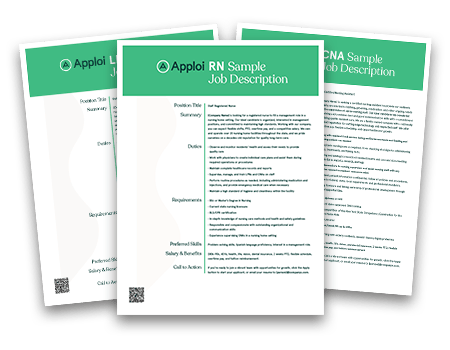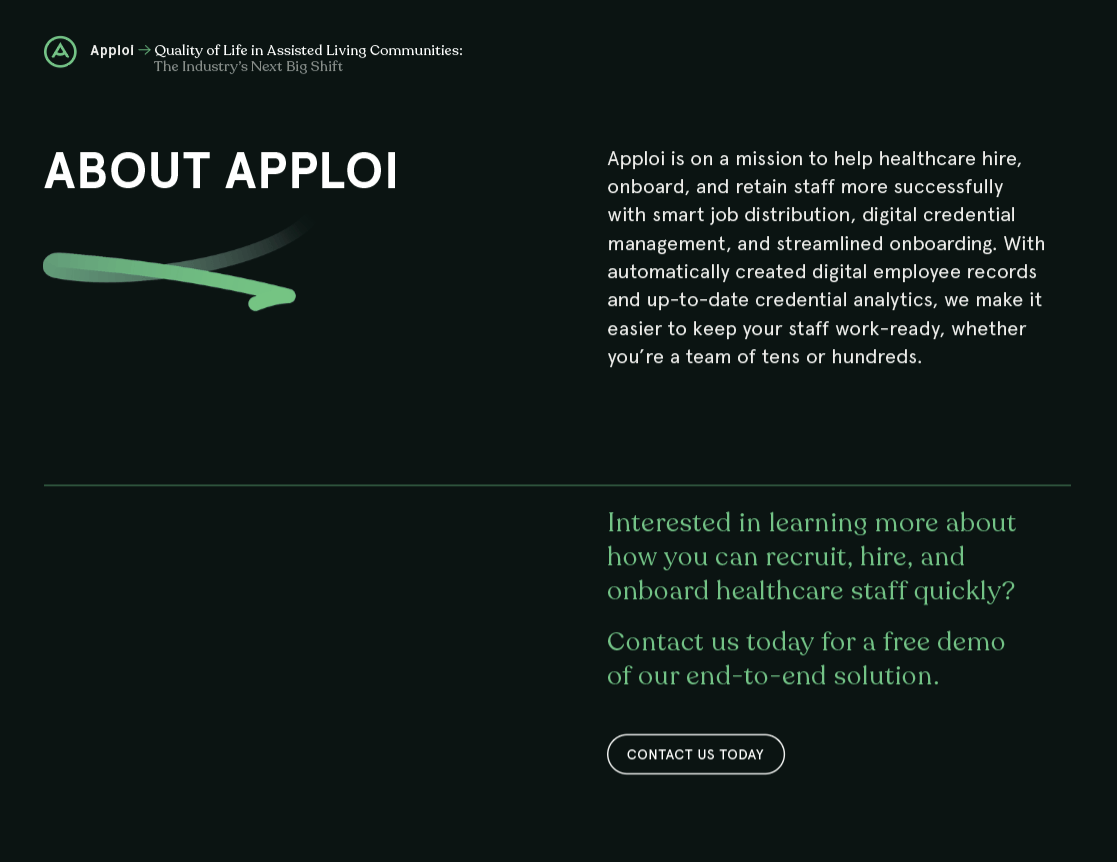
FREE TEMPLATES
Create effective job posts to attract more candidates with our free templates for RN, CNA, and LPN job descriptions
YOUR HEALTHCARE RECRUITING GUIDE
Healthcare recruiting is often challenging, but it’s never impossible. With the right tools and processes, you can control your hiring practices and provide first-rate care, all while building a healthy workplace culture.
We review everything you need to know about healthcare recruiting, from common pitfalls to strategies for success.
Healthcare Recruiting During the Worker Shortage
Let’s face it: it’s not an easy time to be in healthcare recruiting.
Healthcare is facing many hiring challenges, from restrictive budgets to antiquated credentialing systems. But no other issue poses the same challenge to healthcare recruiting as the industry’s infamous worker shortage.
The Healthcare Roles in Highest Demand
In one frequently-cited analysis of Emsi data, Mercer projects that within the next five years, healthcare will be short over 3.2 million lower-wage workers.
While employers are also struggling to find LPNs and RNs, the most extreme shortages are concentrated around fast-growing roles like nursing assistants and home health aides. Although these positions have less stringent educational requirements than RNs or LPNs, they also tend to be among the lower-paid clinical roles.
The Educational Crisis Driving the Worker Shortage
It’s not only clinical facilities that are suffering from candidate shortages. In reality, the clinical worker shortage stems, in part, from another staffing problem: an undersupply of healthcare educators.
In 2019, the American Association of Colleges of Nursing found that over 871 surveyed schools, nursing programs had a total of 1,715 unfilled positions for full-time educators. The surveyed schools reported anywhere from zero to 38 full-time vacancies.
Without adequate healthcare educators, these programs are unable to accept, educate, and graduate enough students to meet the industry’s needs.
Growing Demand for Healthcare Services
In 2034, America is projected to reach a new milestone. For the first time in history, the population of citizens aged 65 and older will be larger than the population of minors.
Healthcare employers can expect both continued increases in retirement rates and greater demands for services. People over age 64 use healthcare services more heavily than any other age cohort, and 84% of older citizens have one or more chronic conditions.
Searching for a Solution
Even with the severe challenges of healthcare recruiting today, there are strategies businesses can employ to recruit and retain staff successfully.
For more information about tackling healthcare recruitment during the worker shortage, check out our free ebook on solving the candidate shortage.

Strategies for Healthcare Recruiting
Healthcare hiring managers might share the same struggle, but there’s no single agreed-upon solution.
In fact, hiring managers employ a whole range of strategies to deal with worker shortages and keep their businesses growing. That’s not to say that every healthcare employer consciously designs their own hiring strategy. Sometimes, strategies take shape organically, formed from the hiring manager’s instincts, budget limitations, and last-minute experiments.
But the most successful healthcare organizations tend to use some combination of the ten strategies listed below. Knowing how and when to use strategies can be the difference between floundering and thriving during healthcare recruiting.
Ten Strategies for Healthcare Recruiting

5 Steps for Faster Healthcare Recruitment
Healthcare recruiting can be infamously slow, with some estimates putting the average time-to-hire in healthcare at 49 days. For competitive employers, that won’t cut it.
FREE EBOOK
Get your guide “How to Keep Candidates Engaged During Recruitment”
Here are five steps to faster hiring.
Step 1: Assess Your Process
Start by understanding exactly where you’re losing time. Complete an audit of your current process to get a clear picture of what needs to change.
Step 2: Make Your Jobs Easy To Find
Help candidates find your open jobs by:
- Distributing job posts widely to a variety of job boards and social media sites.
- Keeping job descriptions updated and accurate.
- Including important keywords in your job description’s body and title.
- Investing in software that will distribute your jobs and track applications for one fee.
Step 3: Enable Easy Apply
Easy apply software lets candidates submit an application in seconds. When managers invest in this software, they encourage more candidates to apply and diversify their candidate pools.
Step 4: Automate Manual Tasks
Automation is a software tool that makes manual and repetitive tasks happen automatically. As a result, it can greatly cut down on hiring managers’ manual work and speed up hiring.
Step 5: Streamline Candidate Communication
Keep communications organized and consisted by:
- Drafting message templates, including offer and rejection letters.
- Sharing these templates with your team.
- Using interview guides while screening candidates.

Where and How To Find Qualified Candidates
Where do great healthcare candidates come from? We have an answer—in fact, we’ve got seven.
Here are some of the top sources of healthcare candidates, tried and tested by successful businesses in the Apploi community.
Seven Sources for Healthcare Candidates

What Hiring Tools Should Healthcare Businesses Use?
There are plenty of healthcare recruiting platforms out there, but the most popular ones fall within these categories.
Job Board
Chances are, you already use job boards. This is any site used primarily to advertise jobs. Candidates can send in their materials directly from the job site, which may then link to a human capital management platform or an applicant tracking system.
Applicant Tracking System
An applicant tracking system (ATS) is a piece of software that hiring managers use to organize all their applicants. An ATS can manage applications from multiple sources. Even if you receive applications from dozens of different job sites, an ATS will give you one central place to go through resumes and screen candidates.
Human Resources Management System
A human resources management system (HRMS) is a platform that HR professionals use to complete a variety of tasks. An HRMS will generally help workers manage payroll, time and attendance, and benefits enrollment. Typically, an HRMS is only used to manage current employee information—not to screen applicants.
Human Capital Management Software
Human capital management (HCM) software bridges the gap between applicant and employee management. Like an ATS, an HCM platform lets users store candidate information, review resumes, and screen applications. But HCM software can also handle ongoing employee management tasks, like credentialing, file storage, and work-readiness reports.

Interested in learning more about tackling healthcare recruiting, hiring, and onboarding from a single platform? Contact us today for your free demo of our human capital management solution.


 Focus on social recruiting.
Focus on social recruiting.

 Center your mission.
Center your mission. Make opportunities for new workers.
Make opportunities for new workers. Leverage current employees.
Leverage current employees. Form a talent pool
Form a talent pool Recruit on multiple channels.
Recruit on multiple channels. Control employer branding.
Control employer branding.

